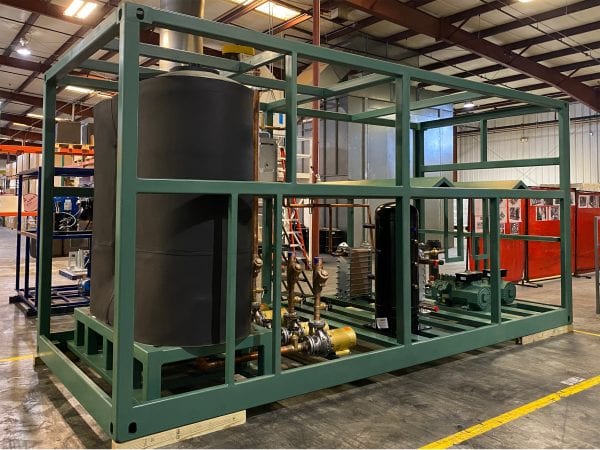‘First’ U.S.-Made CO2 Chiller Set to Be Deployed at California Dairy
By Michael Garry
Published June 28, 2021
Pro Refrigeration, Inc., an Auburn, Washington (U.S.)-based packaged chiller manufacturer, is finishing production on a CO2 (R744)-based chiller that will be used for process cooling and hot water generation at a dairy in Tulare, California (U.S.).
The CO2 chiller, which will replace an HFC chiller at the dairy, is the first of its kind made in the U.S., according to Wynand Groenewald, director, Future Green Now (FGN), a South African consultancy that helped develop the system. “I think it is a massive game changer and will have a huge impact within the refrigeration industry,” he added.
It is the first CO2 project for Pro Refrigeration, a 31-year-old company that specializes in packaged chillers for craft beer producers, wineries, and dairy farms. The CO2 chiller is being manufactured at Pro Refrigeration’s facility in Mocksville, North Carolina (U.S.).
“FGN has been the perfect development partner to complement our team and really made this project possible,” said Jim VanderGiessen, Jr., CEO and Co-Founder of Pro Refrigeration. “We’ve gotten to know them well via our constant video calls and our bi-weekly updates with the customer.”
“Pro brought years of experience within the dairy industry and chillers to the table, and FGN brought their experience on making use of CO2 as a refrigerant,” added Groenewald.

The CO2 chiller is expected to be installed and cooling milk in July at the dairy, owned by Bill Jongsma, said VanderGiessen in a post on Pro Refrigeration’s website. “Bill Jongsma is providing Pro the perfect opportunity to prove that CO2 is not only a viable option the dairy industry should consider, but the best option available today.”
Pro Refrigeration is collaborating with Future Green on additional CO2 systems, which will form its PROGreen Solutions product line. “The first step [is] to complete the development of the CO2-charged packaged chiller systems, while developing our own brand of heat pumps, and partnering on industrial rack applications (non-supermarket), and more,” said VanderGiessen. To that end, the company will be converting current products from f-gas refrigerants to CO2.
“This is such an exciting time to be in the refrigeration industry; natural refrigerants are long overdue in the United States market,” said VanderGiessen. “It’s our goal that by 2022, one of every four systems Pro produces will operate using natural refrigerants.”
“This is such an exciting time to be in the refrigeration industry; natural refrigerants are long overdue in the United States market.” Jim VanderGiessen, Jr., Pro Refrigeration
VanderGiessen said that it was the CO2 system’s highly efficient heat reclamation – which can provide 300% more hot water at higher temperatures – that caught the attention of dairy farmers.
“Because of the higher discharge temperatures, we can heat their potable water, which is used to clean and sanitize the milking equipment and pipelines, to 180°F [82°C],” he said. “This has the potential to eliminate the need for alternative (electric, propane, natural gas) heat sources completely.” The system uses an Alfa Laval heat exchanger for heat reclaim.
For Bill Jongsma Dairy, that means a potential savings of US$2,000 a month currently spent on propane, VanderGiessen added.
The initial CO2 chiller will consist of two 50HP Bitzer compressors, with a total cooling capacity of 862,000 BTUH (71.8TR/252.5kW). Using an already-installed two-stage plate heat exchanger, the system produces “leaving coolant” (propylene glycol) at 35°F (1.7°C) at 90 °F (32.2°C) ambient. (Pro Refrigeration’s full chiller product range will be capable of supplying chilled glycol temperatures between 20°F (-6.7°C) and 35°F.) The CO2 charge of the system is estimated to be 30-40gal.
The CO2 chiller will be about double the price of an equivalent system with R404a, but “we hope this will decrease as production, and supply chains, begin to scale up,” said VanderGiessen.
“Access to required components is not where it should be yet, but what this project did show me is that suppliers are ready to bring what is required to the market, and the support was amazing,” said Groenewald. “I am sure that we will see a reduction in cost soon as these systems become more sought after.”
Without factoring in the energy savings benefit of heat reclaim, VanderGiessen estimates that the chiller system will be “slightly less efficient” than an equivalent R404A system in this part of California. (The hot season in Tulare lasts for 3.7 months, from June 2 to September 23, with an average daily high temperature above 89°F/31.7°C.) However, with heat reclaim, the system is expected to use less overall energy than an HFC system that also uses heat reclaim, because the latter also requires the additional propane heating to reach the 180°F required hot-water temperature. “I’m anxious to prove out the value and effectiveness of the heat recovery,” VanderGiessen said.
VanderGiessen added that the dairy currently uses a 100HP water-cooled condenser, which state law requires it to replace; by converting to an air-cooled gas cooler, the dairy “will keep several million gallons of water in the ground.” (The gas cooler, built in-house, employs coils from Super Radiator Coils and fans from ZIEHL-ABEGG.)
VanderGiessen noted that adiabatic gas cooler, which uses far less water than a water-cooled model, “is very interesting and we are excited to add this in the future.”
However, the dairy application, when heat reclaim is included, “didn’t require adiabatic gas coolers to be more efficient than a Freon system,” noted Groenewald. “We opted to rather save the water and design the system in such a way that cooling will always be possible even at ambient conditions up to 110°F (43.3°C).”
Groenewald also explained that the chiller designers opted to keep the system as simple as possible so that service technicians could get familiar with CO2 technology. Pro Refrigeration is rolling out a comprehensive CO2 training schedule for technicians.
As a result, the decision was made not to include efficiency-enhancing devices like ejectors, which “can be considered in the near future where required and once CO2 is more familiar,”Groenewald said. Instead, the chiller makes use of internal subcooling to improve efficiency as well as VFDs (variable frequency drives) and proper control logic.
“There is a misperception that CO2 cannot work in high ambient conditions, which is not true,” added Groenewald. “Good design and making use of the benefits that CO2 systems can bring can lead to a simple, yet efficient system.”
While this CO2 chiller was specifically designed for industrial food processing (dairy) applications, Groenewald noted that there are other industrial applications requiring heating and cooling that this product can support. “I personally feel that the next worthwhile goal is to go big in terms of capacity,” he said.
Pro’s CO2 chiller range can also be used for air conditioning in that it can supply “the required chilled water that can replace current chilled water systems,” Groenewald said. “Definitely there is an opportunity to support the HVAC sector.”
“We have only scratched the tip of the iceberg and we feel there are ample possibilities with CO2-based chilling and heating technologies,” he said.


